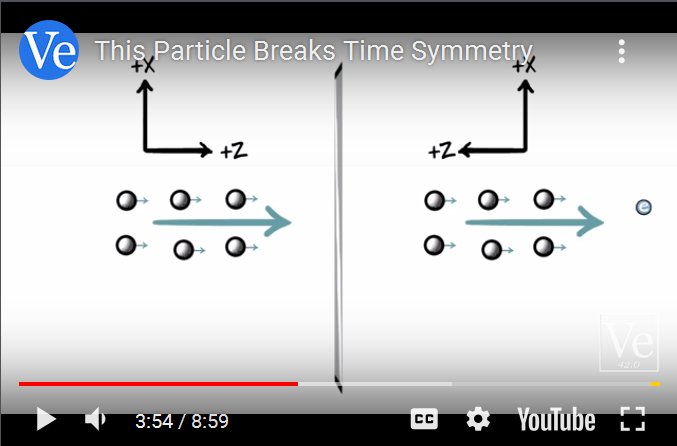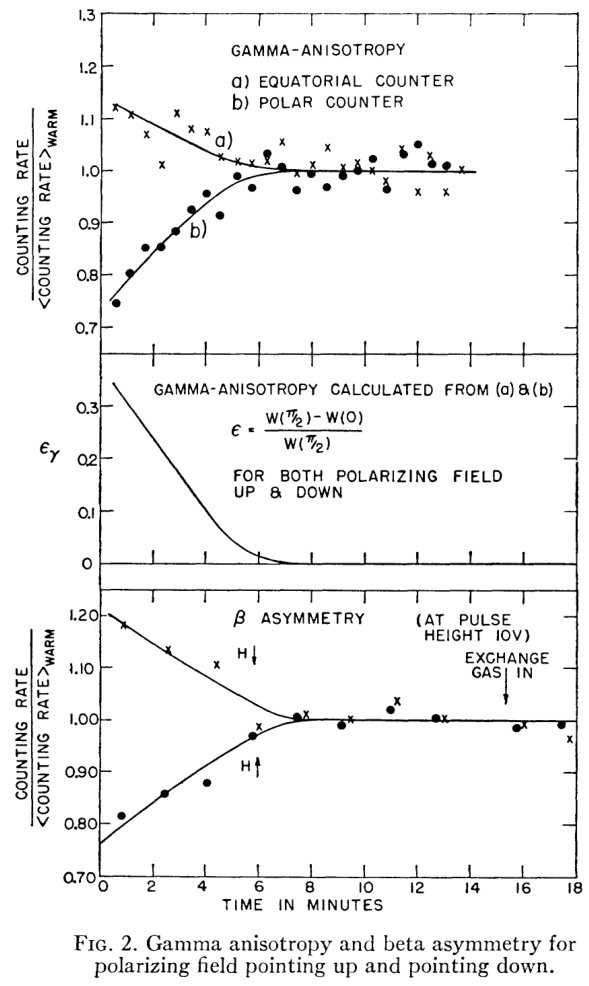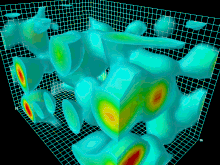It looks like you're using an Ad Blocker.
Please white-list or disable AboveTopSecret.com in your ad-blocking tool.
Thank you.
Some features of ATS will be disabled while you continue to use an ad-blocker.
4
share:
Can any of you geniuses explain spontaneous symmetry breaking in "everyday language"?
Maybe it's something so far outside our scale of comprehension that it can only be approached in mathematical terms.
Which would be where I end up lost every time I try to get to the meat of the matter.
Basically, I can't grasp how a state can "spontaneously" go from symmetrical to asymmetrical. "Something just happens" but how can we conceive of that "something?"
Maybe it's something so far outside our scale of comprehension that it can only be approached in mathematical terms.
Which would be where I end up lost every time I try to get to the meat of the matter.
Basically, I can't grasp how a state can "spontaneously" go from symmetrical to asymmetrical. "Something just happens" but how can we conceive of that "something?"
a reply to: Never Despise
What if I spontaneously decided to smash half of a symmetrical thing with a hammer? That would be some spontaneous asymmetry from symmetry.
Basically, I can't grasp how a state can "spontaneously" go from symmetrical to asymmetrical. "Something just happens" but how can we conceive of that "something?"
What if I spontaneously decided to smash half of a symmetrical thing with a hammer? That would be some spontaneous asymmetry from symmetry.
edit on 4/12/2020 by dug88 because: (no reason given)
People have always taken things out of context or have interpretted what is said based on their beliefs. Consensus of the time has changed, it seems
allowable to do this and back those who take things said out of context now, they voice their opinion without actually evaluating the original words
and how that person meant the words to be taken. Sometimes a person could say something, and two people hear or read the words and they interpret it
both opposite ways, which is not even how the person who said it was trying to portray his speech. Three different interpretations of the speech.
Society is getting scattered and polarized by their personal beliefs, working symbiotically is getting hard these days, social conditioning has failed. I blame the teachers a little, but they are far from the only ones promoting division of interpretation of things. It was not nearly that bad years ago, but it has always been somewhat of a problem. People just used to talk behind people's backs and the ones they talked to saw the disagreement and did not parrot the messed up division.
Society is getting scattered and polarized by their personal beliefs, working symbiotically is getting hard these days, social conditioning has failed. I blame the teachers a little, but they are far from the only ones promoting division of interpretation of things. It was not nearly that bad years ago, but it has always been somewhat of a problem. People just used to talk behind people's backs and the ones they talked to saw the disagreement and did not parrot the messed up division.
OK, even though I was thinking along slightly different lines when I posted
this thread, I like both the above comments for what they are.
edit on 4-12-2020 by Never Despise because: (no reason given)
originally posted by: Never Despise
Can any of you geniuses explain spontaneous symmetry breaking in "everyday language"?
...
I'll give it a shot.
S**t happens...
Doesn't the link posted by you here do that? (which you probably should have posted in the opening post since some people wouldn't know what you're talking about without the link)
originally posted by: Never Despise
Can any of you geniuses explain spontaneous symmetry breaking in "everyday language"?
That link is supposed to be a simple language explanation.
originally posted by: Never Despise
OK, even though I was thinking along slightly different lines when I posted this thread, I like both the above comments for what they are.
It's quantum mechanics, which is outside our everyday experience, so everyday language may not work that well in such cases. Richard Feynman was asked how magnets work, another quantum mechanical phenomenon, and I think most of the youtube comments indicated people didn't understand what he was trying to communicate, which to paraphrase, is that unless you study years to learn quantum mechanics, he's not going to be able to explain to you how magnets work in terms of anything you're already familiar with:
Richard Feynman Magnets
So if he can't explain a simple thing like a magnet, in simple language you can understand, how would it be possible to explain more complex topics like the one you're asking about in simple language that you will understand?
Some of the dumb comments say things like so this guy doesn't know how magnets work, why didn't he just say so. Feynman won a Nobel prize for his QED work which among other things described how magnets work so he should know how magnets work as well as anybody does. Some people think his answer is stupid, in the youtube comments. When you realize his answer is actually brilliant, then you get it, and then may understand why the "simple language" wiki doesn't seem so simple.
edit on 2020124 by Arbitrageur because: clarification
originally posted by: 00018GE
Here’s a good video about symmetry
Wait a minute. At 3:03 its rendered wrong. The particle in the mirror should have its arrow pointing back at the other particle, just like the Z axises are pointing at each other. Objects in the mirror are flipped horizontally. Since its a sphere its just hard to see. If you rendered the arrow correctly then you would see the mirror particle is actually spinning counter clockwise, not clockwise, in relation to the arrow.
Also, is the experiment flawed? They used a magnet to align the spins. Electrons are attracted to magnets, because they are magnets too. So no matter what direction the electrons are emitted from the particles they would likely always flow towards the magnet.
Also, cobalt is ferromagnetic. When they applied the external magnetic field it aligned cobalt particles and magnetized the cobalt. This magnetic field would also have an effect on the emitted electrons.
What am I missing?
edit on 10-12-2020 by More1ThanAny1 because: (no reason given)
I held a matchbook in the mirror and rotated it clockwise. In the mirror image the writing was backward but it was still rotating clockwise so the illustration seems correct.
originally posted by: More1ThanAny1
originally posted by: 00018GE
Here’s a good video about symmetry
Wait a minute. At 3:03 its rendered wrong. The particle in the mirror should have its arrow pointing back at the other particle, just like the Z axises are pointing at each other. Objects in the mirror are flipped horizontally. Since its a sphere its just hard to see. If you rendered the arrow correctly then you would see the mirror particle is actually spinning counter clockwise, not clockwise, in relation to the arrow.
In this case the illustration is not accurate. They didn't use a horseshoe magnet as illustrated, they used a uniform magnetic field generated by a coil.
Also, is the experiment flawed? They used a magnet to align the spins. Electrons are attracted to magnets, because they are magnets too. So no matter what direction the electrons are emitted from the particles they would likely always flow towards the magnet.
He didn't fully describe the experiment, which also measured gamma rays that are not affected by the magnetic field. When the cobalt decays, it emits an electron, an electron antineutrino and two gamma ray photons. He tried to simplify it but the actual experiment was more complex than that.
Also, cobalt is ferromagnetic. When they applied the external magnetic field it aligned cobalt particles and magnetized the cobalt. This magnetic field would also have an effect on the emitted electrons.
What am I missing?
originally posted by: Arbitrageur
I held a matchbook in the mirror and rotated it clockwise. In the mirror image the writing was backward but it was still rotating clockwise so the illustration seems correct.
It's not correct. Like you said, the writing was backward, so your matchbook was actually rotating counter clockwise. From your perspective it only looks clockwise. The render in the video should have had the gray arrows pointing at each other. Instead the arrow of the mirrored object was pointing in the same direction as the original object. That would be equivalent of your matchbook not having backwards writing.
originally posted by: ArbitrageurIn this case the illustration is not accurate. They didn't use a horseshoe magnet as illustrated, they used a uniform magnetic field generated by a coil.
I know they didn't use a U magnet. It doesn't matter what magnet they use, electrons are drawn to magnetic fields.
originally posted by: ArbitrageurHe didn't fully describe the experiment, which also measured gamma rays that are not affected by the magnetic field. When the cobalt decays, it emits an electron, an electron antineutrino and two gamma ray photons. He tried to simplify it but the actual experiment was more complex than that.
I will have to read up on it, but I would think the gamma rays shoot off unpredictably at any direction. The focus is definitely on the electron's direction which would indeed be affected by a nearby magnetic field skewing the direction.
No, they aren't, if the magnetic field is static. What is "drawn to magnetic field" even supposed to mean when the experiment is done inside a coil completely enveloping the electron in a magnetic field? For example, place an electron inside the middle of the magnetic field generated by this coil (which is how the experiment was done, inside a field generated by a coil). In what direction do you expect the electron to be "drawn"?
originally posted by: More1ThanAny1
I know they didn't use a U magnet. It doesn't matter what magnet they use, electrons are drawn to magnetic fields.
Magnetic Field Produced by a Coil
If you answer in any direction, that's wrong, it's not drawn to the magnetic field.
If the electron is moving, then that motion can result in deflection of the electron according to Maxwell's equation, but in the video the magnetic field was oriented horizontally (as in the diagram above), and if the electron is moving parallel to the field lines, even a moving electron won't be deflected by the magnetic field. Note in the video Derek was talking about electrons moving to the left or right, in directions that would be parallel to the field lines, thus not affected by the field but again he over-simplified the experiment.
Magnetic Fields and Magnetic Force Lecture

Note the directions of the electrons discussed in the video were consistent with the second point in that slide. See the electron leaving on the right hand side, it's moving parallel to the field lines, so it won't be deflected by the magnetic field even though the electron is moving.

The experiment showed the preferred direction of the electrons was, in that illustration from the video, to the left, opposite the "spin direction". So in the preferred direction the electrons were unaffected by the magnetic field.
Also there is nothing about the magnetic field that would make the electrons prefer the left over the right, per the illustration.
In the actual experiment, which resulted in a Nobel prize, the apparatus was actually 90 degrees rotated from the illustrations, so the polar directions were up and down, and yes they tried reversing the field too.
Hopefully you learned that the electrons which don't cross the field lines are not affected by the magnetic field. What the gamma rays show is that yes they shoot off unpredictably in any direction after the apparatus has warmed up for about 8 minutes or so.
I would think the gamma rays shoot off unpredictably at any direction. The focus is definitely on the electron's direction which would indeed be affected by a nearby magnetic field skewing the direction
But during the first 6 minutes, they don't. Because of the beta (electron) asymmetry, the gamma ray distribution is also asymmetric. Here is the data plot from the original experiment:
Experimental Test of Parity Conservation in Beta Decay

edit on 20201210 by Arbitrageur because: clarification
new topics
-
SCOTUS Chief Justice JOHN ROBERTS Ends 2024 Describing His Fears for Safety of U.S. Judges.
Above Politics: 6 hours ago
top topics
-
I dont understand what i just witnessed
Social Issues and Civil Unrest: 16 hours ago, 12 flags -
US disburses $3.4 billion in budget aid for Ukraine, Yellen says
US Political Madness: 13 hours ago, 11 flags -
How we've changed in 100 years
Ancient & Lost Civilizations: 12 hours ago, 8 flags -
Nigel Farage's New Year Message.
Politicians & People: 15 hours ago, 6 flags -
SCOTUS Chief Justice JOHN ROBERTS Ends 2024 Describing His Fears for Safety of U.S. Judges.
Above Politics: 6 hours ago, 3 flags
active topics
-
US disburses $3.4 billion in budget aid for Ukraine, Yellen says
US Political Madness • 19 • : KrustyKrab -
I dont understand what i just witnessed
Social Issues and Civil Unrest • 20 • : KrustyKrab -
SCOTUS Chief Justice JOHN ROBERTS Ends 2024 Describing His Fears for Safety of U.S. Judges.
Above Politics • 8 • : WeMustCare -
Simulation theory and have we reset before like a game?
Conspiracies in Religions • 38 • : G1111B1234 -
Get Ready - Here comes the Bird Flu Pandemic - Millions are Notified
Diseases and Pandemics • 56 • : rickymouse -
Reflections of Elections past
US Political Madness • 12 • : mysterioustranger -
-@TH3WH17ERABB17- -Q- ---TIME TO SHOW THE WORLD--- -Part- --44--
Dissecting Disinformation • 3872 • : duncanagain -
Strange fog all over the northern hemisphere
General Conspiracies • 37 • : annonentity -
The C.D.C. Says There Was NO INFLUENZA Worth Reporting for the 2020-2021 Flu Season.
Diseases and Pandemics • 56 • : KrustyKrab -
House republicans prove to be drama queens
US Political Madness • 6 • : rickymouse
4


